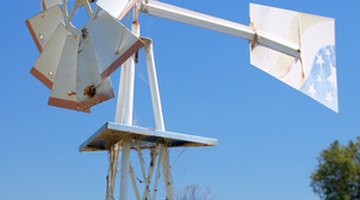How to Build a Wind Mill Water Pump
A wind mill harnesses the power of the wind to lift water from an underground source to the surface, where it flows either directly into fields or into storage tanks. Invented in Connecticut in 1854 by Daniel Halladay, the American version of the windmill could lift water from hundreds of feet below the surface.

Things You Will Need
- Water well
- Windmill
- Wind odometer (optional)
Tip
Some modern windmill manufacturers include Aermotor, Dempster and Baker Monitor.
Because of the efficiency of a modified version about 30 years later, windmills' design has been virtually unchanged ever since. As long as a property has a ground-water supply and sufficient wind to turn the windmill, use of the technology is possible.
-
Locate the best site for your windmill. A windmill should stand a minimum of 25 feet above anything that could obstruct the wind, with at least 150 feet of clearance all around it. Next, find out average wind speed for your area. This can be done by simply calling a local airport or weather station. Or you can set up an anemometer, or wind odometer, to measure wind speed and volume over the course of a year, measure the number of miles of wind that blows past your property, then divide that figure by the total number of hours it ran to get the average wind speed for your site.
-
Find a reputable well driller. If the driller predicts that water will be found too far away from your optimal windmill location, you may either need to compromise or drop the project altogether. A small, non-commercial windmill pumps only 3 to 5 gallons of water per minute, but your concern is with “drawdown,” which is the rate at which the pump will lower the water level in the well. If the refreshment rate, which is the amount of water flowing into the well, at least equals the amount of water being drawn, the windmill is viable.
-
Install your windmill. While windmills fell out of favor when electricity became plentiful, they've made a comeback, with literally hundreds of thousands of them now operating all over the world. If your budget won't allow for a new one, thousands of used windmills are available; you'll find them in advertisements in farm journals and online. Spare parts will almost certainly be needed, and are available from windmill manufacturers or even made to specification by a machine shop.
References
Writer Bio
Bert Wylen began writing professionally in 1979. His articles have appeared in “The Burlington County Times,” “The Philadelphia Inquirer,” “The Philadelphia Gay News,” Brandywine.Net Business Report, “Daily Local News,” "The Courier-Post," “Small Business News,” “Software Developer & Publisher,” “The Advocate” and for radio networks Pacifica and Public Radio International. Wylen holds a Bachelor of Arts in English literature from Temple University.
Photo Credits
- Windmill image by Siew Yee Lee from Fotolia.com
- Windmill image by Siew Yee Lee from Fotolia.com
More Articles



